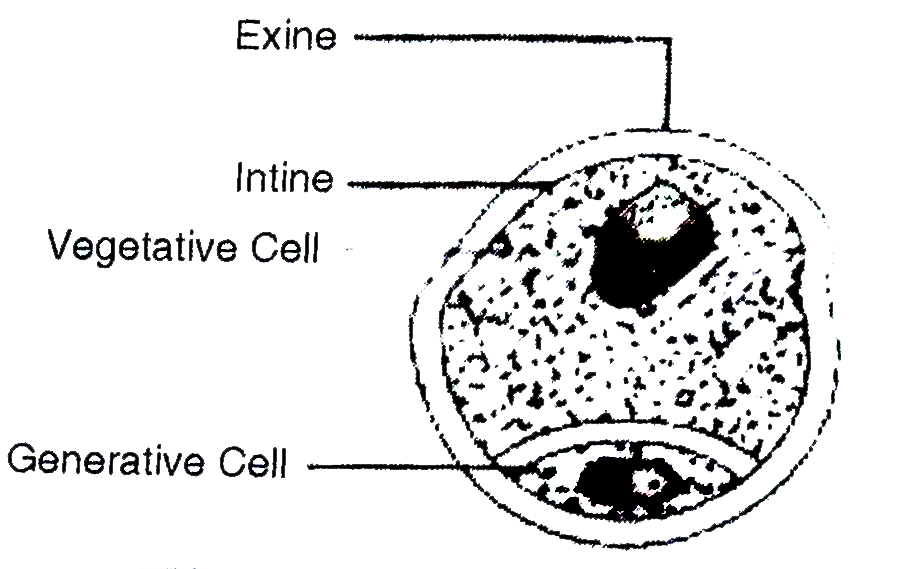Draw a labelled diagram of the sectional view of a mature pollen grain in angiosperms. Explain the functions of its different parts.
Step-by-Step Solution:
1. Draw the Sectional View of a Mature Pollen Grain:
- Start by sketching a round or oval shape to represent the pollen grain.
- Divide the pollen grain into two main layers: the outer layer (exine) and the inner layer (intine).
- Inside the pollen grain, draw two nuclei: one larger (vegetative nucleus) and one smaller (generative nucleus).
2. Label the Parts of the Diagram:
- Label the outer layer as "Exine" and indicate that it is the protective layer.
- Label the inner layer as "Intine" and note that it is involved in forming the pollen tube.
- Label the larger nucleus as "Vegetative Nucleus" and explain that it forms the pollen tube upon germination.
- Label the smaller nucleus as "Generative Nucleus" and clarify that it produces gametes.
3. Provide Explanations for Each Part:
- Exine: This is the tough outer layer that protects the pollen grain from environmental factors and desiccation. It is often sculptured and can have various patterns that are species-specific.
- Intine: This is the inner layer of the pollen grain, which is softer and more delicate than the exine. It plays a crucial role in the germination process by forming the pollen tube that will deliver sperm cells to the ovule.
- Vegetative Nucleus: This nucleus is responsible for the growth of the pollen tube. When the pollen grain lands on a compatible stigma, the vegetative nucleus directs the formation of the pollen tube, which penetrates the style to reach the ovule.
- Generative Nucleus: This nucleus divides to form two male gametes (sperm cells) during the process of pollen tube growth. These gametes are essential for fertilization of the ovule.
- Start by sketching a round or oval shape to represent the pollen grain.
- Divide the pollen grain into two main layers: the outer layer (exine) and the inner layer (intine).
- Inside the pollen grain, draw two nuclei: one larger (vegetative nucleus) and one smaller (generative nucleus).
- Label the outer layer as "Exine" and indicate that it is the protective layer.
- Label the inner layer as "Intine" and note that it is involved in forming the pollen tube.
- Label the larger nucleus as "Vegetative Nucleus" and explain that it forms the pollen tube upon germination.
- Label the smaller nucleus as "Generative Nucleus" and clarify that it produces gametes.
- Exine: This is the tough outer layer that protects the pollen grain from environmental factors and desiccation. It is often sculptured and can have various patterns that are species-specific.
- Intine: This is the inner layer of the pollen grain, which is softer and more delicate than the exine. It plays a crucial role in the germination process by forming the pollen tube that will deliver sperm cells to the ovule.
- Vegetative Nucleus: This nucleus is responsible for the growth of the pollen tube. When the pollen grain lands on a compatible stigma, the vegetative nucleus directs the formation of the pollen tube, which penetrates the style to reach the ovule.
- Generative Nucleus: This nucleus divides to form two male gametes (sperm cells) during the process of pollen tube growth. These gametes are essential for fertilization of the ovule.
Similar Questions
Draw a labelled diagram of the sectional view of a mature pollen grain of angiosperms. Explain the function of generative cell and vegetative cell
 View Solution
View SolutionDraw a labeled diagram of a section through ovary.
View SolutionDraw a labelled diagram of the T.S. of a mature anther.
View SolutionDraw a labelled diagram of the T.S. of a mature anther.
View SolutionDraw a labelled diagram of the T.S. Of a mature anther.
View SolutionDraw a labelled diagram of a section of an enlarged view of microsporangium of an angiosperm.
View Solution(a) Draw a labelled diagram of the sectional view of microsporangium of an angiosperm.
(b) Explain the development of male gametophyte in the microsporangium.View SolutionDraw a labelled diagram of the longitudinal section of a flower.
View SolutionDraw a labelled diagram of the transverse section of a long bone.
View SolutionDraw a labelled diagram of cross section of human spinal cord.
View Solution

